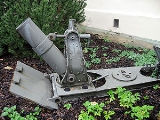
14 cm Minenwerfer M 15
Encyclopedia
The 14 cm Minenwerfer M 15 was a medium mortar
used by Austria-Hungary
in World War I
. It was developed by Škoda Works
as an alternative to a German design from Rheinische Metallwarenfabrik/Ehrhardt
for which ammunition could not be procured. It was a rigid-recoil, rifled, muzzle-loading weapon that had to be levered around to aim at new targets. It was lifted onto a two-wheel cart for transport.
The M 16 version added a central barrel ring and cutouts on the side of the carriage. Rotation within the barrel was improved, greatly increasing accuracy. It weighed an extra 20 kilograms (44.1 lb), but had a maximum range of 1080 metres (1,181.1 yd). Its transport cart was also improved.
The first batch of 100 mortars was ordered in May 1915 and a second batch in spring 1916, but deliveries were slow; only 88 of the second batch could be sent to the front by May 1916. A third batch of 300 was ordered in November 1916, but production was such that only 30 had been delivered by the spring of 1917.
Mortar (weapon)
A mortar is an indirect fire weapon that fires explosive projectiles known as bombs at low velocities, short ranges, and high-arcing ballistic trajectories. It is typically muzzle-loading and has a barrel length less than 15 times its caliber....
used by Austria-Hungary
Austria-Hungary
Austria-Hungary , more formally known as the Kingdoms and Lands Represented in the Imperial Council and the Lands of the Holy Hungarian Crown of Saint Stephen, was a constitutional monarchic union between the crowns of the Austrian Empire and the Kingdom of Hungary in...
in World War I
World War I
World War I , which was predominantly called the World War or the Great War from its occurrence until 1939, and the First World War or World War I thereafter, was a major war centred in Europe that began on 28 July 1914 and lasted until 11 November 1918...
. It was developed by Škoda Works
Škoda Works
Škoda Works was the largest industrial enterprise in Austro-Hungary and later in Czechoslovakia, one of its successor states. It was also one of the largest industrial conglomerates in Europe in the 20th century...
as an alternative to a German design from Rheinische Metallwarenfabrik/Ehrhardt
Rheinmetall
Rheinmetall AG is a German automotive and defence company with factories in Düsseldorf, Kassel and Unterlüß. The company has a long tradition of making guns and artillery pieces...
for which ammunition could not be procured. It was a rigid-recoil, rifled, muzzle-loading weapon that had to be levered around to aim at new targets. It was lifted onto a two-wheel cart for transport.
The M 16 version added a central barrel ring and cutouts on the side of the carriage. Rotation within the barrel was improved, greatly increasing accuracy. It weighed an extra 20 kilograms (44.1 lb), but had a maximum range of 1080 metres (1,181.1 yd). Its transport cart was also improved.
The first batch of 100 mortars was ordered in May 1915 and a second batch in spring 1916, but deliveries were slow; only 88 of the second batch could be sent to the front by May 1916. A third batch of 300 was ordered in November 1916, but production was such that only 30 had been delivered by the spring of 1917.

